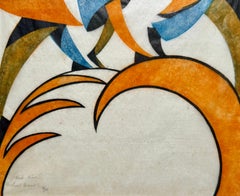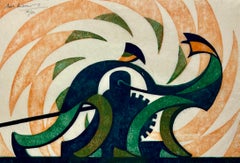William Greengrass
1930s Modern Figurative Prints
Linocut
1930s Modern Figurative Prints
Linocut
1930s Modern Figurative Prints
Linocut
People Also Browsed
Mid-20th Century British Chandeliers and Pendants
Glass
20th Century German Posters
Paper
Antique 1890s French Louis XVI Bookcases
Brass
1940s Modern Black and White Photography
Silver Gelatin
Vintage 1950s French Mid-Century Modern Armchairs
Fabric, Wood
20th Century Art Deco Dining Room Tables
Macassar, Wood
1930s American Modern Landscape Prints
Lithograph
1920s American Modern Portrait Prints
Drypoint
Mid-20th Century American Modern Abstract Prints
Screen
21st Century and Contemporary Commodes and Chests of Drawers
Ash
1930s American Modern Figurative Prints
Lithograph
2010s Abstract Impressionist Abstract Paintings
Gold Leaf
Vintage 1960s Italian Mid-Century Modern Posters
Linen, Paper
Vintage 1950s Danish Scandinavian Modern Sideboards
Brass
1940s American Modern Figurative Paintings
Cotton Canvas, Oil
Late 20th Century American Chinoiserie Sofas
Fabric, Upholstery, Wood
Sybil Andrews for sale on 1stDibs
Sybil Andrews was an English-Canadian artist who specialized in printmaking and is best known for her reductionist linocuts. Born in 1898 in Bury St Edmunds, Andrews was unable to go straight to art school after her high school, as her family could not afford the tuition fees. Given the shortage of young men during the First World War, in 1916 she was apprenticed as a welder, working in the Bristol Welding Company’s airplane factory, helping in the development of the first all-metal airplane. During this period, she took an art correspondence course. After the war, Andrews returned to Bury St Edmunds, where she was employed as an art teacher at Portland House School. Between 1922–24, she attended the Heatherley School of Fine Art in London. Andrews continued to practice the art and met the architect Cyril Power, who became a mentor figure, and then her working partner until 1938. Between 1930–38, Andrews and Power shared a studio in Hammersmith. In 1933, Andrews and Cyril Power had an exhibition of their color monotypes and linocuts at the Redfern Gallery. Most of her monotypes were destroyed by a fire in an Ottawa gallery, in 1959 and they are therefore now seldom seen.
A Close Look at Modern Art
The first decades of the 20th century were a period of artistic upheaval, with modern art movements including Cubism, Surrealism, Futurism and Dadaism questioning centuries of traditional views of what art should be. Using abstraction, experimental forms and interdisciplinary techniques, painters, sculptors, photographers, printmakers and performance artists all pushed the boundaries of creative expression.
Major exhibitions, like the 1913 Armory Show in New York City — also known as the “International Exhibition of Modern Art,” in which works like the radically angular Nude Descending a Staircase by Marcel Duchamp caused a sensation — challenged the perspective of viewers and critics and heralded the arrival of modern art in the United States. But the movement’s revolutionary spirit took shape in the 19th century.
The Industrial Revolution, which ushered in new technology and cultural conditions across the world, transformed art from something mostly commissioned by the wealthy or the church to work that responded to personal experiences. The Impressionist style emerged in 1860s France with artists like Claude Monet, Paul Cézanne and Edgar Degas quickly painting works that captured moments of light and urban life. Around the same time in England, the Pre-Raphaelites, like Edward Burne-Jones and Dante Gabriel Rossetti, borrowed from late medieval and early Renaissance art to imbue their art with symbolism and modern ideas of beauty.
Emerging from this disruption of the artistic status quo, modern art went further in rejecting conventions and embracing innovation. The bold legacy of leading modern artists Georges Braque, Pablo Picasso, Frida Kahlo, Salvador Dalí, Henri Matisse, Joan Miró, Marc Chagall, Piet Mondrian and many others continues to inform visual culture today.
Find a collection of modern paintings, sculptures, prints and other fine art on 1stDibs.
Finding the Right Figurative-prints-works-on-paper for You
Bring energy and an array of welcome colors and textures into your space by decorating with figurative fine-art prints and works on paper.
Figurative art stands in contrast to abstract art, which is more expressive than representational. The oldest-known work of figurative art is a figurative painting — specifically, a rock painting of an animal made over 40,000 years ago in Borneo. This remnant of a remote past has long faded, but its depiction of a cattle-like creature in elegant ocher markings endures.
Since then, figurative art has evolved significantly as it continues to represent the world, including a breadth of works on paper, including printmaking. This includes woodcuts, which are a type of relief print with perennial popularity among collectors. The artist carves into a block and applies ink to the raised surface, which is then pressed onto paper. There are also planographic prints, which use metal plates, stones or other flat surfaces as their base. The artist will often draw on the surface with grease crayon and then apply ink to those markings. Lithographs are a common version of planographic prints.
Figurative art printmaking was especially popular during the height of the Pop art movement, and this kind of work can be seen in artist Andy Warhol’s extensive use of photographic silkscreen printing. Everyday objects, logos and scenes were given a unique twist, whether in the style of a comic strip or in the use of neon colors.
Explore an impressive collection of figurative art prints for sale on 1stDibs and read about how to arrange your wall art.


